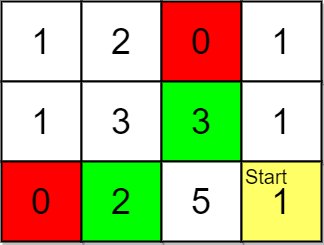2146. K Highest Ranked Items Within a Price Range

,%20Matrix-orange.svg)
Description
You are given a 0-indexed 2D integer array grid of size m x n that represents a map of the items in a shop. The integers in the grid represent the following:
0represents a wall that you cannot pass through.1represents an empty cell that you can freely move to and from.- All other positive integers represent the price of an item in that cell. You may also freely move to and from these item cells.
It takes 1 step to travel between adjacent grid cells.
You are also given integer arrays pricing and start where pricing = [low, high] and start = [row, col] indicates that you start at the position (row, col) and are interested only in items with a price in the range of [low, high] (inclusive). You are further given an integer k.
You are interested in the positions of the k highest-ranked items whose prices are within the given price range. The rank is determined by the first of these criteria that is different:
- Distance, defined as the length of the shortest path from the
start(shorter distance has a higher rank). - Price (lower price has a higher rank, but it must be in the price range).
- The row number (smaller row number has a higher rank).
- The column number (smaller column number has a higher rank).
Return the k highest-ranked items within the price range sorted by their rank (highest to lowest). If there are fewer than k reachable items within the price range, return all of them.
Example 1:

Input: grid = [[1,2,0,1],[1,3,0,1],[0,2,5,1]], pricing = [2,5], start = [0,0], k = 3 Output: [[0,1],[1,1],[2,1]] Explanation: You start at (0,0). With a price range of [2,5], we can take items from (0,1), (1,1), (2,1) and (2,2). The ranks of these items are: - (0,1) with distance 1 - (1,1) with distance 2 - (2,1) with distance 3 - (2,2) with distance 4 Thus, the 3 highest ranked items in the price range are (0,1), (1,1), and (2,1).
Example 2:

Input: grid = [[1,2,0,1],[1,3,3,1],[0,2,5,1]], pricing = [2,3], start = [2,3], k = 2 Output: [[2,1],[1,2]] Explanation: You start at (2,3). With a price range of [2,3], we can take items from (0,1), (1,1), (1,2) and (2,1). The ranks of these items are: - (2,1) with distance 2, price 2 - (1,2) with distance 2, price 3 - (1,1) with distance 3 - (0,1) with distance 4 Thus, the 2 highest ranked items in the price range are (2,1) and (1,2).
Example 3:

Input: grid = [[1,1,1],[0,0,1],[2,3,4]], pricing = [2,3], start = [0,0], k = 3 Output: [[2,1],[2,0]] Explanation: You start at (0,0). With a price range of [2,3], we can take items from (2,0) and (2,1). The ranks of these items are: - (2,1) with distance 5 - (2,0) with distance 6 Thus, the 2 highest ranked items in the price range are (2,1) and (2,0). Note that k = 3 but there are only 2 reachable items within the price range.
Constraints:
m == grid.lengthn == grid[i].length1 <= m, n <= 1051 <= m * n <= 1050 <= grid[i][j] <= 105pricing.length == 22 <= low <= high <= 105start.length == 20 <= row <= m - 10 <= col <= n - 1grid[row][col] > 01 <= k <= m * n
Solution
class Solution:
def highestRankedKItems(self, grid: List[List[int]], pricing: List[int], start: List[int], k: int) -> List[List[int]]:
rows, cols = len(grid), len(grid[0])
heap = []
sx, sy = start
minP, maxP = pricing
queue = deque([(sx, sy, 0)])
visited = set([(sx, sy)])
while queue:
x, y, distance = queue.popleft()
price = grid[x][y]
if price != 1 and minP <= price <= maxP:
if len(heap) == k:
heapq.heappushpop(heap, (-distance, -price, -x, -y))
else:
heapq.heappush(heap, (-distance, -price, -x, -y))
for dx, dy in [(x + 1, y), (x - 1, y), (x, y + 1), (x, y - 1)]:
if 0 <= dx < rows and 0 <= dy < cols and grid[dx][dy] != 0 and (dx, dy) not in visited:
queue.append((dx, dy, distance + 1))
visited.add((dx, dy))
return [[-x, -y] for _, _, x, y in sorted(heap, reverse = 1)]